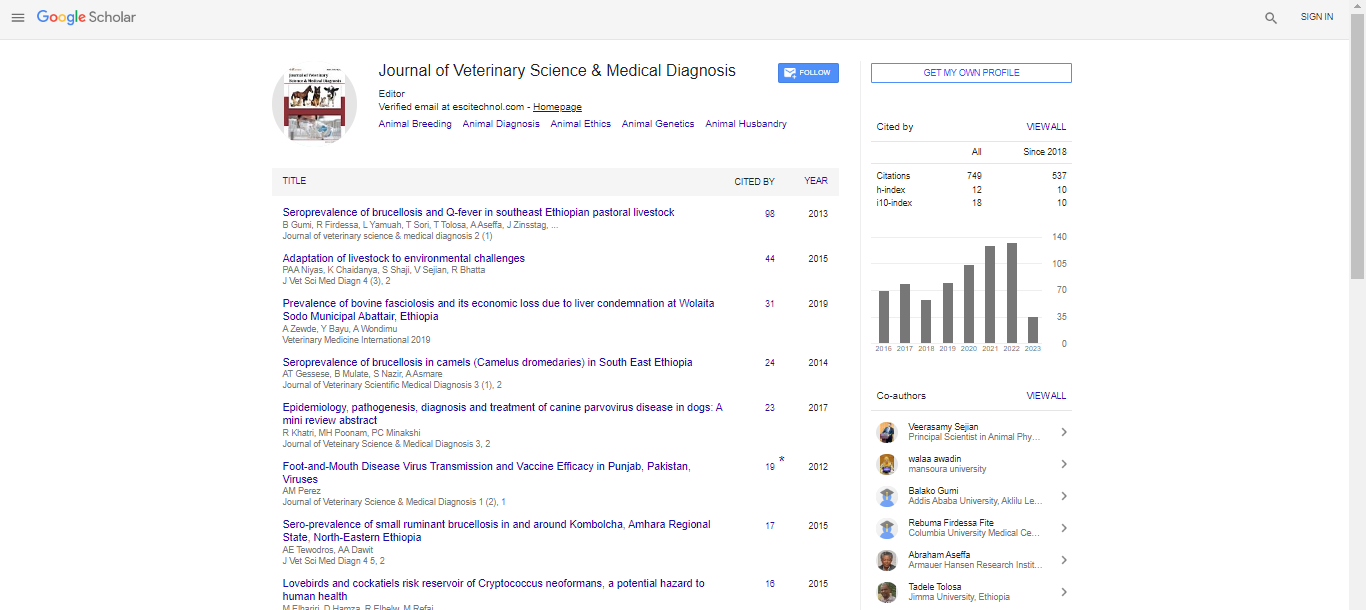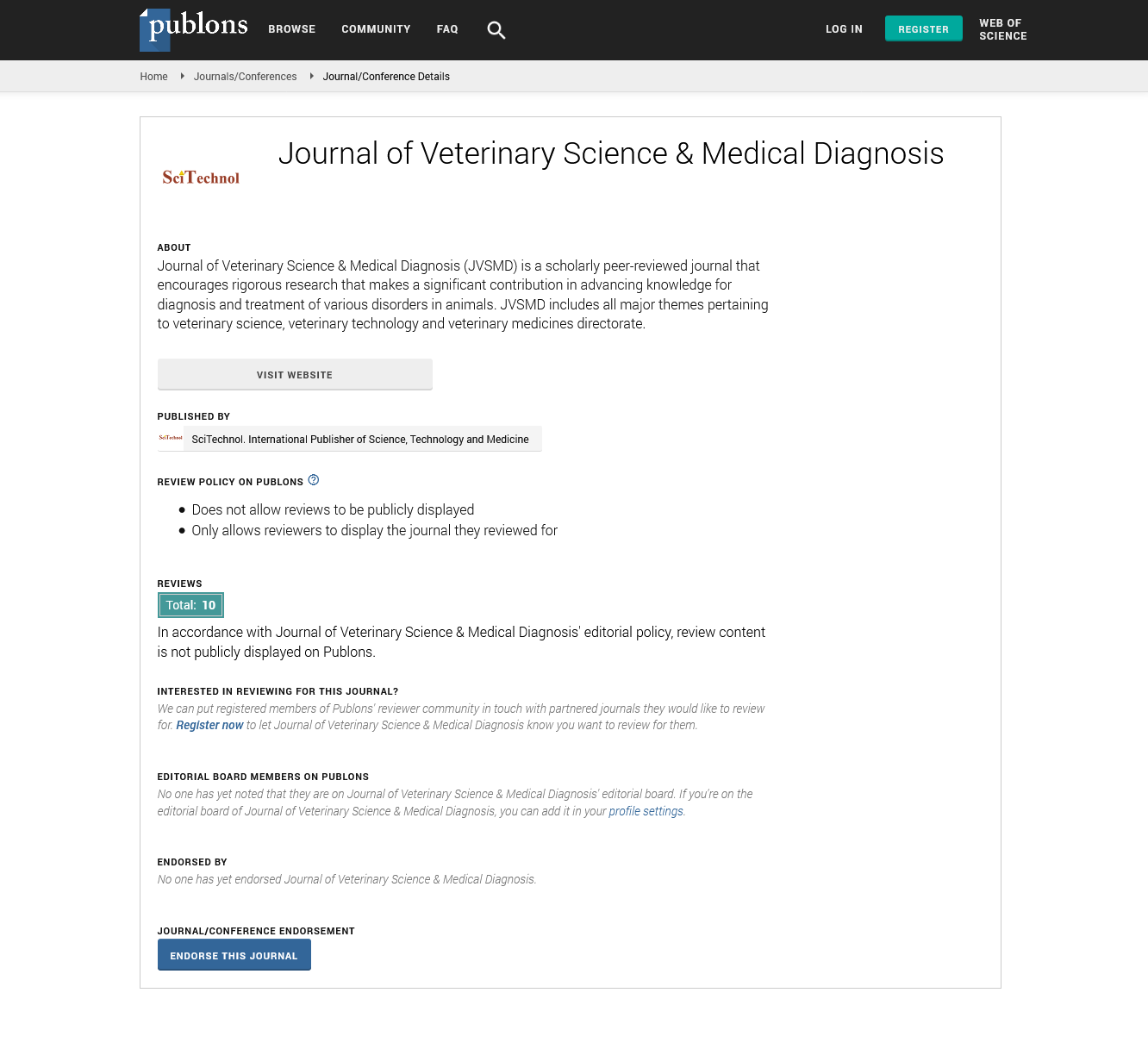Perspective, J Vet Sci Med Diagn Vol: 11 Issue: 2
Potential Applications for Exotic Animal and Clinical Electro Diagnostic
Adolf Davidson*
Department of Clinical Sciences, Faculty of Veterinary Medicine, University of Montreal, Saint-Hyacinthe, Quebec, Canada
*Corresponding Author: Adolf Davidson
Department of Clinical Sciences, Faculty of Veterinary Medicine, University of Montreal, Saint-Hyacinthe, Quebec, Canada.
E-mail: addavidson@hotmail.com
Received date: 03 January, 2022, Manuscript No. JVSMD-22-60929;
Editor assigned date: 05 January, 2022, Pre QC No. JVSMD-22-60929 (PQ);
Reviewed date: 17 January, 2022, QC No. JVSMD-22-60929;
Revised date: 03 February, 2022, Manuscript No. JVSMD-22-60929 (R);
Published date: 15 February, 2022, DOI:10.4172/2325-9590.11.1.008
Citation: Davidson A (2022) Potential Applications for Exotic Animal and Clinical electro diagnostic. J Vet Sci Med Diagn 11:2.
Keywords: Exotic Animal
Description
Extraordinary creatures are obviously missing in financial chronicles and conversations of material culture in eighteenth-century Britain, despite the fact that they were profoundly soughtafter extravagance merchandise. As a reaction, this social history is a stage towards a more full comprehension of the expansive yet related implications that a scope of outlandish creatures held in Georgian Britain. A review is organized around four topics of significance. The meaning of extraordinary creatures is investigated, thusly, through their capacity as items, as objects of tactile experience, as political images and appealling material for physical examination. The spaces through which creatures moved, the settings of their showcase and the implications various crowds delivered are considered all through.
The truth of fascinating creatures as items is laid out through a background marked by creature dealers in London and, from that point, their more extensive spot in eighteenth-century Britain is perceived. The improvement of creature exchange from nomad bird merchants to top of the line zoos tell, when examined, a story uncovering a standard yet huge piece of business and exhibitionary culture. By historicising the tangible experiences of onlookers, readings of more extensive social tensions about malodour and the substantial vicinity of ladies and youngsters to creatures are conceivable. The faculties were overseen and requested around outlandish creatures, and it is contended that encountering them in this period was predicated on unambiguous and fluctuating thoughts of chance and danger. Fascinating creatures procured political imagery, particularly in issues of government. Affiliations were created and coursed by open portrayals that foregrounded humor, political parody, sexuality, extravagance and style. Entwined inside these worries were not kidding and not so genuine conversation about Enlightenment perspectives and the Improvement of Nature. It is contended all through that new spaces arose for the spectatorship of outlandish creatures during the long eighteenth century, and, accordingly, that these creatures ought to be historicised as eighteenth-century British peculiarity.
Native Versus Exotic Animals
Sometimes, obtrusive plants have been found to intercede hunter prey associations through territory creation and shelter from predation. These circuitous associations can likewise be interceded by means of changes in leaf litter amount or quality, similarly as with the intrusive European bird cherry that altogether decreases invertebrate prey sponsorships to coho salmon. In arthropods, much work has zeroed in on ruthless insects as they can influence trophic fountains to prey and plants. For instance, orb-weaving insects have been displayed to increment extensively in number following the presentation of new design for web working from the intrusive spotted knapweed. As individual investigations of intrusive plant impacts on creatures, meta-analyses and audits pursued searching for bigger directions. An early meta-analysis took a gander at the reverse, i.e., the job local and extraordinary herbivores have on intrusive plant overflow, observing that local herbivores stifle and outlandish herbivores work with obtrusive plants. In a systematic audit of North American bird species affected by invasive plants, tracked down impartial consequences for overflow and mortality, yet adverse consequences on wealth. An undifferentiated from review in arthropods observed a lessening in animal groups lavishness on obtrusive plant has contrasted with local hosts, however couldnt contrast trophic levels due with information restrictions. meta-analysis of 198 examinations, that obtrusive plants essentially diminished creature overflow, variety, and wellness; however these impacts fluctuated fundamentally among biological system, creature trophic level, and creature scientific classification. Obtrusive plant impacts were most grounded in riparian frameworks, while birds and bugs were the most firmly affected creature gatherings. In a wide correlation of intrusive plant consequences for trophic levels, McCary, Mores, Farfan, and Wise (2016) tracked down obtrusive plants to have differential effects.
Species with a High Risk of Establishment
In any case, examinations of faunal collections recuperated from archaic archeological settings are constantly established in current scientific classification, utilize efficient ordered terminology to guarantee reliable distinguishing proof and draw on contemporary natural, environmental and ethological analogs to remake the morphology and conduct of creatures before, informed by contemporary composed and imaginative sources. The assessment of the actual remaining parts of non-native species brought into different locales of Europe from the 11th to the fifteenth century presents a valuable chance to coordinate current and middle age scientific classifications and conceptualizations of the regular world. This approach regards Pastoureau's admonition (cited prior) and ought not to be mistaken for 'logic'. A realist expert working inside the bounds of an advanced ordered framework sees the distinguishing proof of intriguing and 'nonexistent' creatures in middle age (and Classical) social orders as the consequence of misconception and messy reasoning fully intent on adjusting this disarray, and accordingly rationalizing manticores as cheetahs, yales as Indian water bison, and unicorns. It is valuable to recognize an antique portrayed as a unicorn horn as a narwhal tusk in that it gives data about its topographical and social beginning, but it is similarly helpful and fundamental to think about its distinguishing proof as a unicorn - contacting not just on inquiries of morphology, change and use yet additionally on conceptualizations in various geological and social settings. In this regard a zooarchaeological approach treats the actual remaining parts of exotica - in some cases recuperated from unearthings however more frequently surviving in private assortments having never been covered, or having been uncovered, or covered and recuperated before - as material culture, and all the more explicitly as specific sorts of antiquities molded by, yet in addition forming human reactions.
It merits commenting not just the curiosity of these and different portrayals of creatures remembered for the writing related with the Portuguese disclosures yet in addition the way that at minimum some of them depended on direct perception. As a matter of fact, most of the creators had gone toward the East and some of them had remained for certain years in the areas portrayed in their works. The vast majority of them were engaged with the Portuguese endeavors to overcome and assemble exchanging joins with the East. Antonio Galvao, for instance, was Captain of the Molucas while he composed his composition on this archipelago and Duarte Barbosa was an agent in the tradingstation of Cananor. To be sure, a portion of the creators of Portuguese travel writing knew about the worth of individual involvement with the experience with and depiction of nature.15 Pires called attention to that We here have experienced everything, and experienced it and seen it Similarly, Duarte Pacheco Pereira in his Esmeraldo de Sito Orbis portrayed insight as the mother of information, eliminates all uncertainty and misunderstanding'. Whats more, esteemed 'Information on encounters made.
 Spanish
Spanish  Chinese
Chinese  Russian
Russian  German
German  French
French  Japanese
Japanese  Portuguese
Portuguese  Hindi
Hindi 
